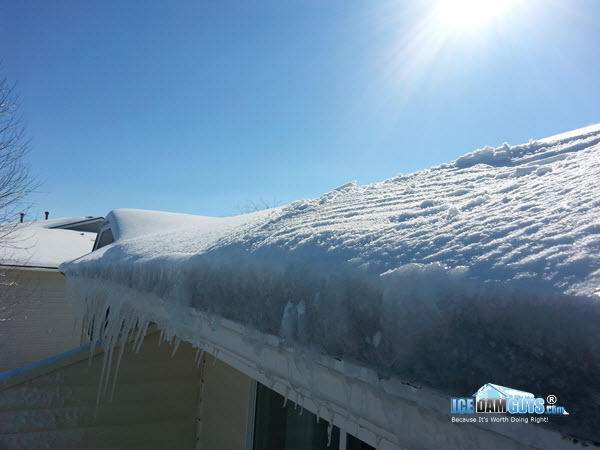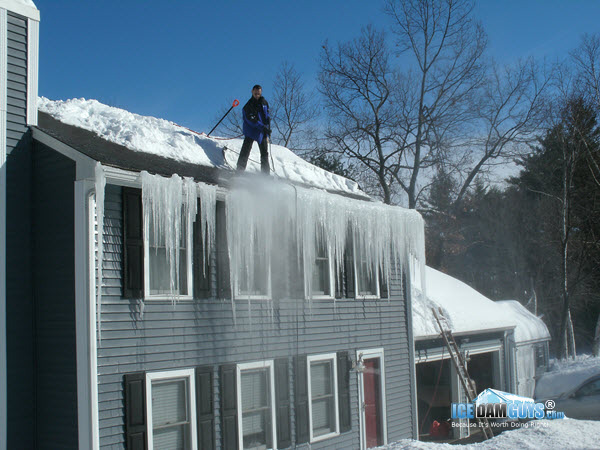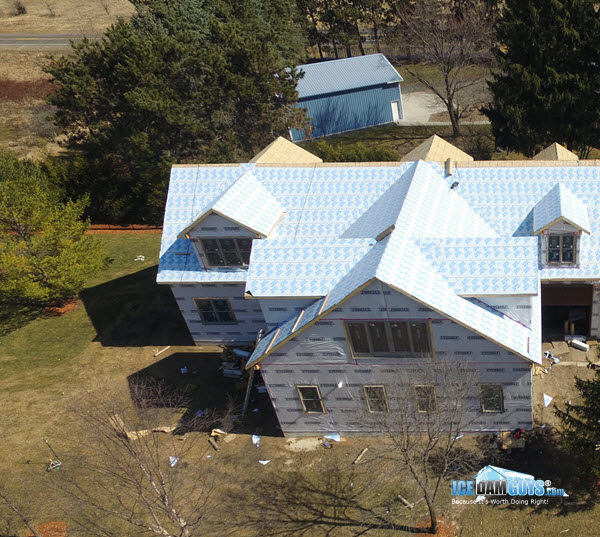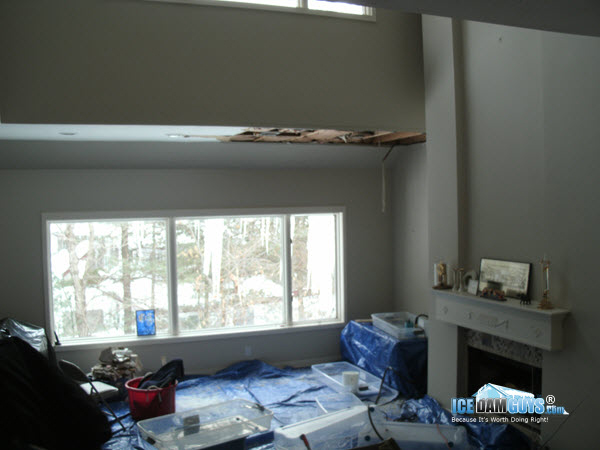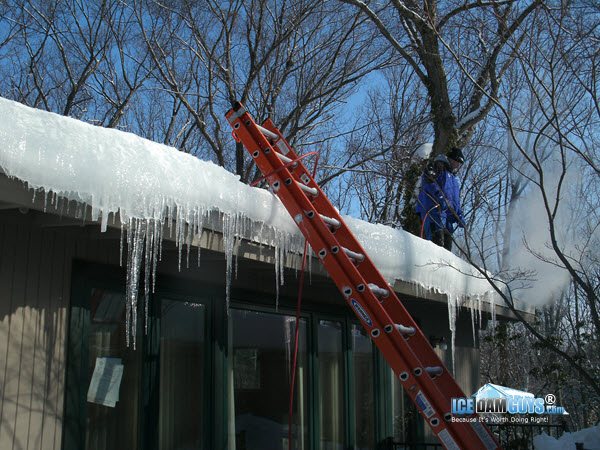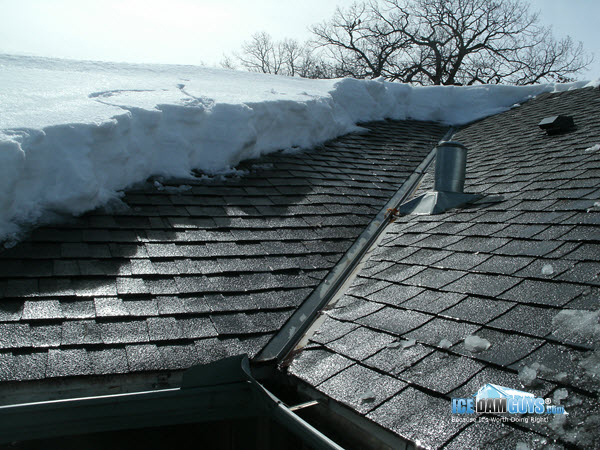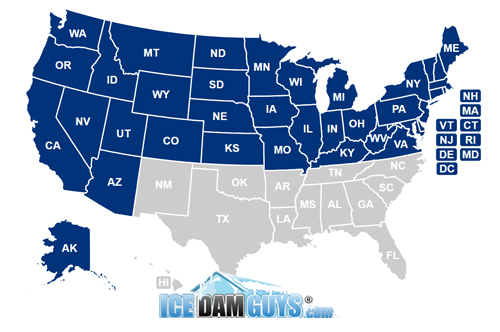Ice Dam Glossary & Definitions
Heard an ice-dam-related word you didn’t know? We’ve put together this glossary for you.
Whether you heard that unfamiliar term from an ice dam removal company, or from a contractor who’s helping you make your home more ice-dam-proof, you should be able to find the definition here. Please contact us if there’s an ice-dam-related definition we’re missing.)
Click on a word to jump down to the definition:
Attic bypass
Attic vent
Dry steam
Gable vent
Granules
Gutter guard
Heat cables
Ice dam
Ice dam melt
Ice dam prevention
Ice dam remediation
Ice dam removal
Ice jam
Ice & water shielding
Interior damage
Overhang
Pantyhose method
R-value
Ridge
Ridge vent
Roof deck
Roof rake
Roof raking
Roof snow removal
Roof pitch
Runoff
Salt pucks
Soffit
Steamer
Valley
Wall Cavity
Wet Steam
Attic bypass
Is any area where warm air can leak into the attic from the living space of a home, often due to poor insulation on or around the area. Examples of thermally leaky areas include light fixtures, chimneys, air ducts, attic hatches, plumbing, bathroom exhaust fans, kitchen exhaust fans, smoke detectors, and virtually any other penetrations into the walls or ceilings. Sealing or improving the insulation on or around attic bypasses is crucial to reducing heat in the attic, which in turn can help prevent ice dams from forming.
(back to the top)
Attic vent
Is any vent designed to circulate hot air out of the attic. Those include louvered vents on the gable or side of the home, soffit vents, cupola vents, whirlybirds, power vents, box vents, and ridge vents.
(back to the top)
Dry steam
Is an industry term that frequently is used in a misleading way among ice dam removal companies. The technical definition of “dry steam” is that it is an emission of pure steam, without any liquid water mixed into the stream (see “wet steam“). However, ice dam removal companies almost never use dry steam; they may use dryer steam. In any case, wet steam is more effective at removing ice dams than dryer steam is.
(back to the top)
Gable vent
Is a vent used on the gable end of a roof. Not only do these vents help warm air escape from your attic, but they are also often used as a decorative feature on most homes.
(back to the top)
Granules
Are the small, pebble-like bits of a shingle. The granules provide most of the protective qualities of shingles, and are responsible for the “rough” texture of most shingles. You can rub off some of your roof granules by raking your roof with a rake that doesn’t have small plastic rollers or bumpers on the bottom, or by improperly using a high-powered pressure washer when removing ice dams.
(back to the top)
Gutter guard
Is a covering with small holes or a small gap that snaps onto the top of your gutters, meant to keep out debris but let water through. Gutter guards do not cause ice dams, but they do make ice dams more difficult and time-consuming to remove, and they really get in the way if you want us to de-ice your gutters.
(back to the top)
Heat cables
Are installed on a roof – typically on the overhangs – to prevent the buildup of ice. Of questionable effectiveness at preventing ice dams. Also known as heat tape or heat wire.
Ice dam
Is a ridge of ice that typically forms along the edge of a roof and prevents melting snow from draining off of the roof. Ice dams can also form in roof valleys, around skylights, vents, and anywhere two inclined sides of the roof meet. For more detail, see our page on “What Is an Ice Dam?”
Ice dam melt
Refers to any substance meant to be placed or thrown on your roof in an attempt to melt ice dams. Those products almost always consist of some form of pelletized salt or various chlorides (including pucks).
(back to the top)
Ice dam prevention
Is an effort to prevent ice dams from forming on a roof. Most ice dam prevention methods are ineffective. Typically, the best way to prevent ice dams is to take steps to reduce heat in the attic (or the space directly under the roof deck) and to keep snow off the roof.
(back to the top)
Ice dam remediation
See “ice dam removal.”
(back to the top)
Ice dam removal
Is the removal of an ice dam (or several ice dams) from a roof. The only safe and effective way to remove an ice dam is with steam, preferably a minimum of 250F.
Ice jam
A mispronunciation of “ice dam.”
(back to the top)
Ice & water shielding
Is a waterproof membrane that is installed on a roof, underneath the shingles. When installed correctly, it is an excellent way to prevent ice dams from causing interior leaks.
Interior damage
In the context of ice dams, interior damage refers to any damage caused by water leaking through the roof as a result of ice dams. Ceilings, walls, flooring, insulation, wiring, furniture, and valuables may be damaged as a result. Repairing interior damage caused by roof leaks tends to cost many times what ice dam removal costs.
Overhang
Is the part of the roof that extends beyond the footprint of the building (also referred to as an eave). The overhang part of the roof extends beyond the living space (or exterior walls) of a home or other building, and is not heated from underneath. Ice dams form most often on the overhang, because the overhangs are colder than the rest of the building, because there’s no heated living space beneath the overhangs. Melting snow runoff often refreezes on contact with overhangs, resulting in ice damming.
Pantyhose method
Is a common technique used by DIY-ers to attempt to prevent ice dams. They fill a stocking with ice melt (salt or chloride), place the stocking over the ice dam, and allow it to melt through down to the roofing material. The hope is that it will allow backed-up water behind the ice dam to flow off the roof. Though popular, this is not a very effective method, and can damage roofing material, yard foliage, gutters, etc.
(back to the top)
R-value
Is a measure of how well a piece of insulation can resist the flow of heat. The higher the R-value, the more effective the insulation. You may encounter this term when you get a home energy audit and receive recommendations on how to improve the insulation in your attic and perhaps elsewhere in your home.
(back to the top)
Ridge
Is the highest point of a roof, where two slopes meet. The ridge often spans the length of the home. Ice dams rarely form on or near the ridge. A ridge vent is an important part of ventilating the attic, so as to minimize the chances of ice dams forming.
(back to the top)
Ridge vent
Is a type of attic vent running along the ridge of a roof, with openings on both sides of the ridge. Effective at letting some warm air out of the attic, though typically not enough by itself to prevent the buildup of warm air and the formation of ice dams.
(back to the top)
Roof deck
Is the layer of wood sheathing underneath the shingles (and directly on top of the roof trusses) on a typical home. If an ice dam causes water to leak through the shingles and there is not a sufficient layer of ice and water shielding underneath, the roof deck can be damaged and allow water to leak into the interior of the home.
(back to the top)
Roof rake
Is a flat-headed rake with a long handle (or many handle extensions), meant to allow a homeowner to remove snow from the roof while standing on the ground. Highly effective as an ice dam prevention method, because roof-raking is the easiest way to keep snow off your overhangs and out of the lower parts of your roof valleys.
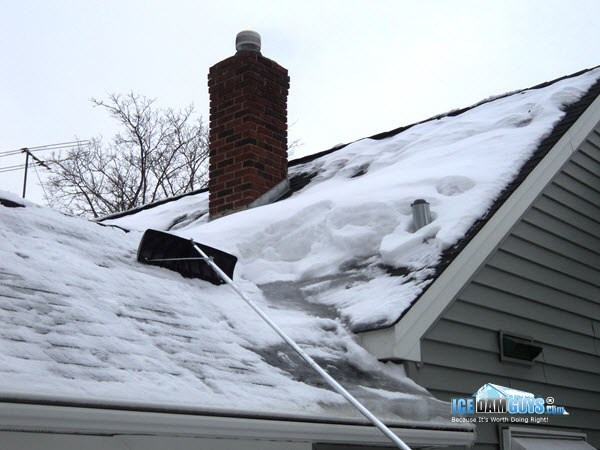
Here is a roof rake kit we use and recommend, and here’s a standalone roof rake we use and recommend.)
Roof raking
Is the act of using a roof rake to remove snow from a roof (typically the roof overhangs).
Roof snow removal
Often synonymous with roof-raking, but can also refer to shoveling the snow off a roof. Crucial for preventing ice dams, particularly on a house with a warm attic caused by inadequate attic insulation or ventilation.
(back to the top)
Roof pitch
Is a measure of how steep a roof is. Flat or shallow-pitched roofs tend to collect more snow and be more likely to form ice dams, because water (from melted snow) can’t run off as easily. Roofs with a steeper pitch tend to collect less snow and are less likely to pool water.
(back to the top)
Runoff
Is snow that melts into water and runs down the shingles of a roof. When it comes into contact with a colder part of a roof, like the overhangs or valleys, the runoff often forms an ice dam.
(back to the top)
Salt pucks
Are discs of salt that are meant to melt holes in ice dams, so as to allow water to run off of the roof, rather than continue to pool up. Salt pucks are largely ineffective, and can discolor or otherwise damage roof shingles, yard foliage, gutters, etc.
(back to the top)
Soffit
Is the underside of the overhang on a roof. Soffits often have vents to let outside air into the attic.
(back to the top)
Steamer
Also known as an ice dam steamer, steam machine, or steamer. Used by ice dam removal companies to melt ice dams safely and (with proper technique) without damaging the roofing materials or exacerbating a roof leak.
(back to the top)
Valley
Is the area where two roof sloped roofs intersect, often at 90-degree angles. Roof valleys are most commonly found on homes with gables and dormers. Ice dams are more likely to form in the valleys than on any other part of the roof, except for overhangs, for 3 reasons: (1) water from melted snow often runs through the valleys of a roof, (2) valleys tend to collect more snow, and (3) valleys are lower than most of the hot air in the attic, which means that they are especially cold and more likely to freeze any runoff that flows through them.
Wall cavity
Is the space between the interior walls of your home and the exterior. The cavity tends to be filled with insulation, among other things. An ice dam that causes an interior leak can damage the wall cavities by filling them with moisture (the insulation soaks up water like a sponge), which in turn can cause damage to your interior walls and allow harmful mold to grow.
(back to the top)
Wet steam
Is a mixture of steam and water. Highly effective at steaming ice dams, more so than dry steam is. The combination of the steam’s heat (ideally around 250F) and the fact that water droplets retain heat better than steam can makes wet steam more effective at removing ice dams.
(back to the top)















